Eggplant, also known as aubergine, is a delicious fruit. By botanical definition, the Eggplant flowers is a berry, however, it is typically used as a vegetable in a variety of different dishes.
Contrary to popular belief, eggplants are actually grown from eggplant flowers that have been pollinated.
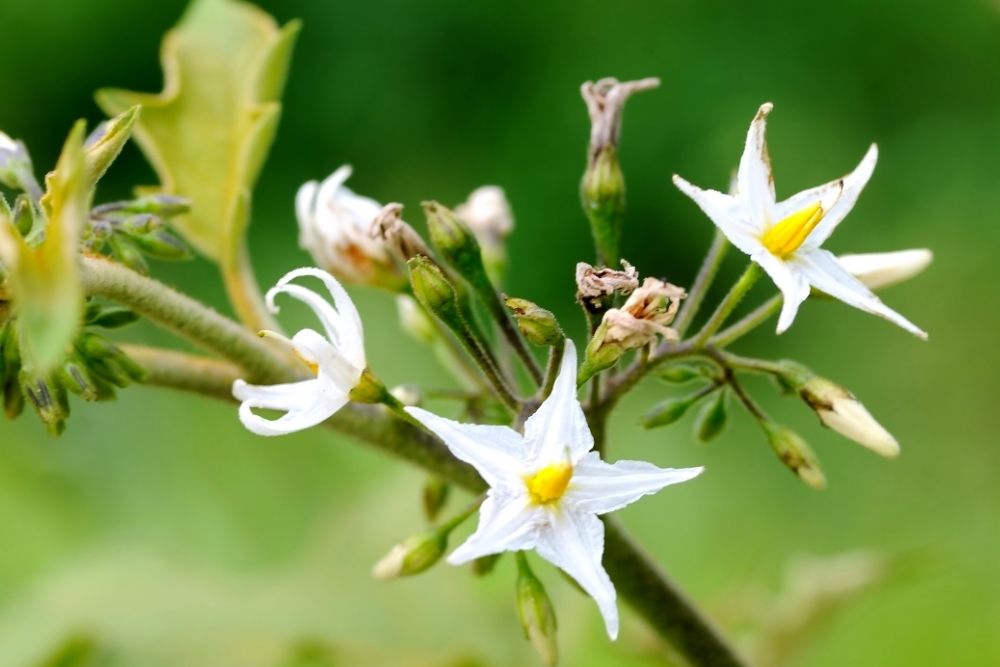
In this article, I will cover flowers that are the color of an eggplant. So, whether you’re looking to learn more about flowers, or need inspiration on what to plant in your garden, you’re covered!
Without further ado, let’s begin.
RELATED: Black Bean Plants And Other Bonus Bean Plants (With Pictures)
Eggplant Flowers
The eggplant is a perennial plant. Although referred to as eggplants in countries such as America, in European countries such as France, Germany, and The Netherlands, alongside the United Kingdom, the fruit is known as aubergine.
The fruits grow from flowers that are white to purple in color, and have five-lobed petals and yellow stamens. While some common cultivars of eggplant flowers produce fruit that has glossy, dark purple skin with white flesh that has a spongy texture when raw.
Alternatively, some other cultivars are white and longer in shape.
The eggplant is a self pollinating plant which has both male as well as female organs in one flower. The fruit of the eggplant will not grow in the female part of the flower until it is pollinated with male pollen.
An eggplant flower is normally wind pollinated. However, when it comes to growing eggplants inside, once the flowers begin to bloom, you will need to make sure that you shake the plant every day to ensure that the pollen falls from anther (male) to pistil (female) in each individual flower.
Depending on the type of eggplant and where you are planting them, different varieties of eggplant will typically produce fruit within 50 to 80 days after they have begun to flower. On wild plants, typically speaking the fruit is less than 3 cm in diameter.
On the other hand, in cultivated forms the fruit usually grows up to 30 cm. The flowers and leaves can be poisonous due to solanine, meaning that they should never be eaten in vast quantities.
Pruning your eggplant flowers is important if your plant has already gone through a period of production and seems like it’s starting to slow down.
This comes down to the fact that getting rid of these fruits that are hindering your plant will allow the plant to focus more of its energy on fruit production, resulting in larger, more impressive eggplants.
Flowers Similar To Eggplant Flowers
1. Primula Scotica
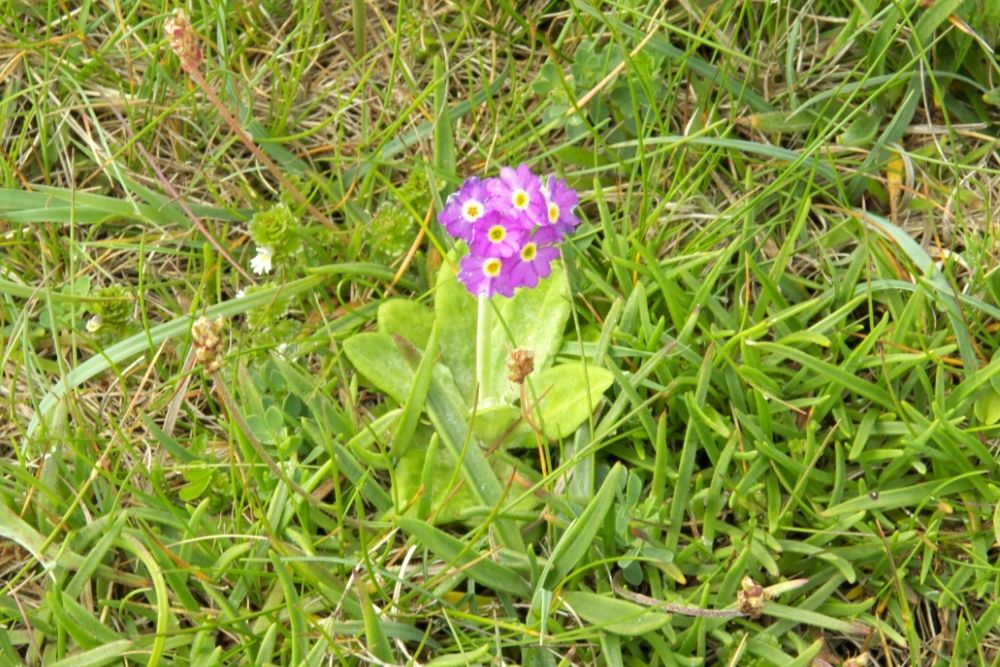
Primula scotica, also known as the Scottish primrose, is a rare perennial wildflower endemic to the north coast of Scotland.
Primula scotica has purple flowers with a yellow center, making it look very similar to the eggplant flower. The flowers are small even in full bloom, and the sepals are rounded and somewhat blunt.
Primula scotica grows in coastal heaths and grassland, and these flowers typically bloom twice each year. While the first flowering takes place in the early spring, the second time occurs during the summer.
These flowers bloom best when planted in full sun to partial shade in moist but well-drained soil. As a result, these flowers thrive in areas that have cool summers.
2. Primula Vulgaris
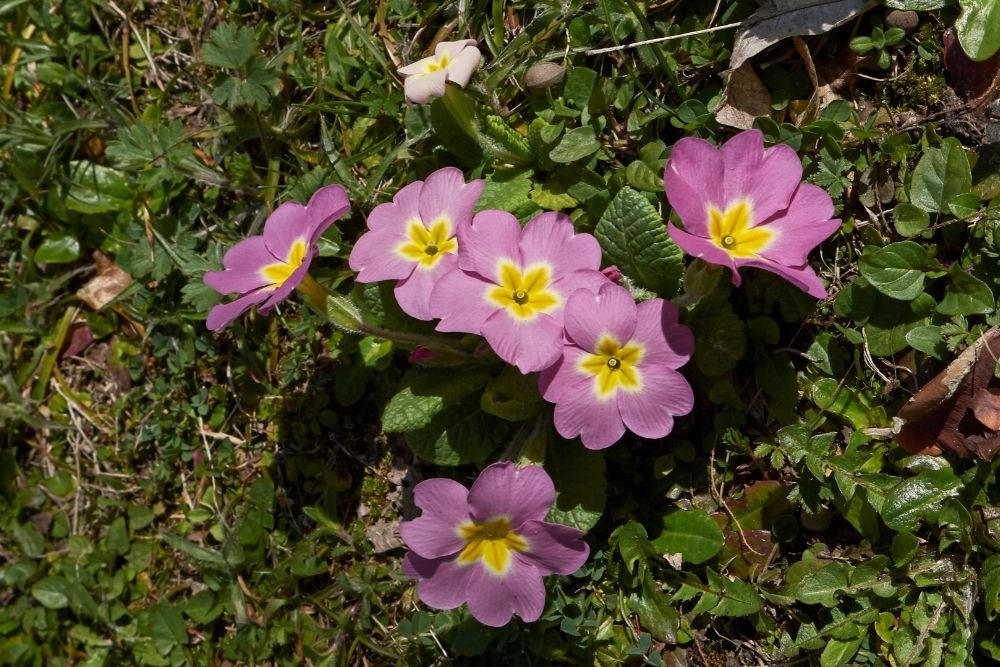
Primula vulgaris, also known as the common primrose, is a flower native to western and southern Europe, northwest Africa, as well as parts of southwest Asia.
Primroses come in a variety of colors, including purple, which is similar to eggplant flowers. These flowers can bloom as early as late December and bloom until late spring in May.
Primula vulgaris is known to attract butterflies, moths, bees, and other pollinators to your garden, and makes a great neighboring plant when grown next to daffodils which flower at the same time.
However, it’s important to note that primula vulgaris can be toxic to animals such as cats, dogs, and horses, so be mindful of planting it if you have pets.
RELATED: Lean, Mean, and Dark Green: The Ultimate Guide to Dark Green Veggies
3. Forget-Me-Not
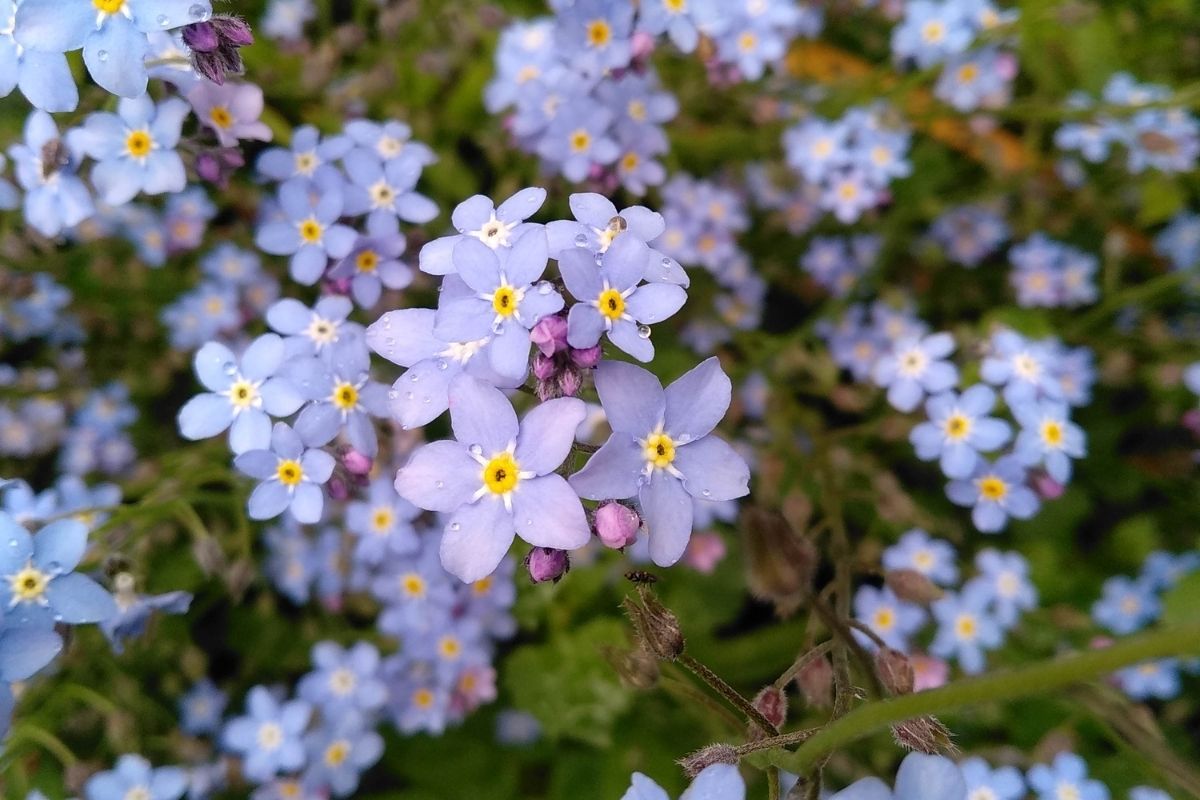
Myosotis arvensis, more commonly known as the forget-me-not, is a short lived perennial flowering plant. The name for forget-me-nots comes from the Ancient Greek for “mouse’s ear,” which the foliage is thought to resemble.
The blooms of forget-me-nots are generally blue with yellow centers, making them similar in color to eggplant flowers, although they are smaller in size. That being said, they come in a variety of different colors, such as white, yellow, and pink.
At the southern end of its range, forget-me-nots will require afternoon shade. In the North, however, you have the option of growing it in full sun or partial shade.
Forget-me-nots reseed all on their own and will therefore multiply over time. Once you introduce it to your flower beds and begin growing it in your garden, you’ll have it for many years to come. This makes it a wonderful addition for a more casual gardener.
4. Anemone Blanda

Anemone blanda is a hardy perennial that bears large, daisy-like flowers that typically have 5 petals. These flowers will typically start to flower in the spring but some do flower in the autumn.
The blooms of anemone blandas come in a range of colours, including blue, purple, pink and white. The blue variation with yellow centers are similar to that of eggplant flowers.
There is no pruning required for anemone blanda to thrive, making it a very low maintenance flower to grow in your backyard. That being said, for the best results, these flowers need to be grown in well-drained soil in full sun or partial shade.
These stunning flowers make wonderful neighboring flowers and compliment English bluebells well when planted together.
5. Purple Pansy

The pansy is a hybridized flower that produces long-blooming flowers. The blooms produced by pansies come in a variety of different colors, including purple pansies which have similar yellow centers and purple petals like eggplant flowers, only slightly darker in color.
Other petal colors for pansies are usually white, yellow, purple, or blue, but there are variations of pansies that are more than one color (bi-color).
Pansies are winter hardy, and these flowers grow beautifully in the sunny or partially sunny locations, requiring well-draining soil in order to thrive.
If planted during the autumn, pansies can last as long as eight months. From September all the way up to April or May, their beautiful blooms can brighten your garden all the way through winter and spring.
6. Purple Crocus

The crocus is a flowering plant in the iris family that is found in woodland and meadows in a variety of different continents across the world.
Typically speaking, the crocus blooms during the late winter all the way up to early spring and sometimes autumn depending on the variety.
Crocuses bloom in a variety of different colors, including purple, lavender, blue, orange, yellow, cream and white. The purple varieties are quite similar in appearance to eggplant flowers.
These flowers are great for planting in borders, beds, and containers. Crocuses will multiply and come back years after year, bringing more and more blooms back each time.
The fact that they bloom bright and early means that they bring a splash of much needed color after a long winter, breathing life back into your garden!
7. Viola
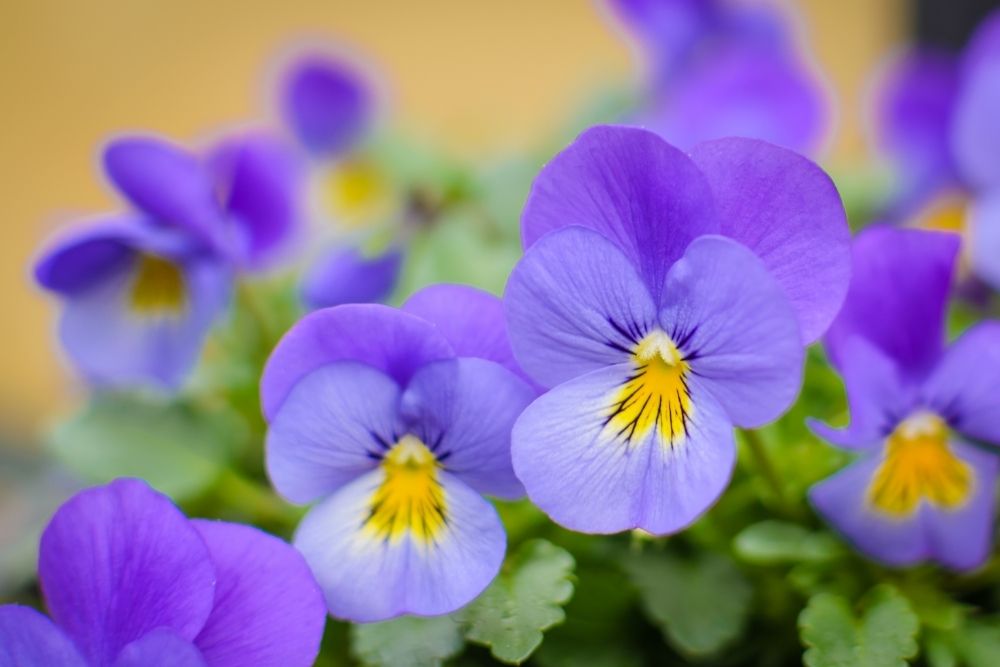
Viola is a flowering plant in the violet family found in the Northern Hemisphere, as well as Hawaii, the Andes, and Australasia.
Violas grow back year after year, and thrive best in full sun or partial shade. The majority of violas are reliably hardy and can withstand frosts, and even a hard freeze.
These flowers have long flowering periods, bringing a blanket of vibrant color to any garden. Their blooms range from light violet, purple-black, peach, white, blue, yellow, and cream. Purple violas are similar to eggplant flowers, in that they have stunning purple petals with a yellow middle.
Due to the fact that violas can self-seed and can spread throughout your garden on their own, they are often referred to as Johnny jump-ups in the United States of America.
RELATED: The Color Purple: The Ultimate Guide To Purple Colored Veggies
8. Thunbergia Erecta
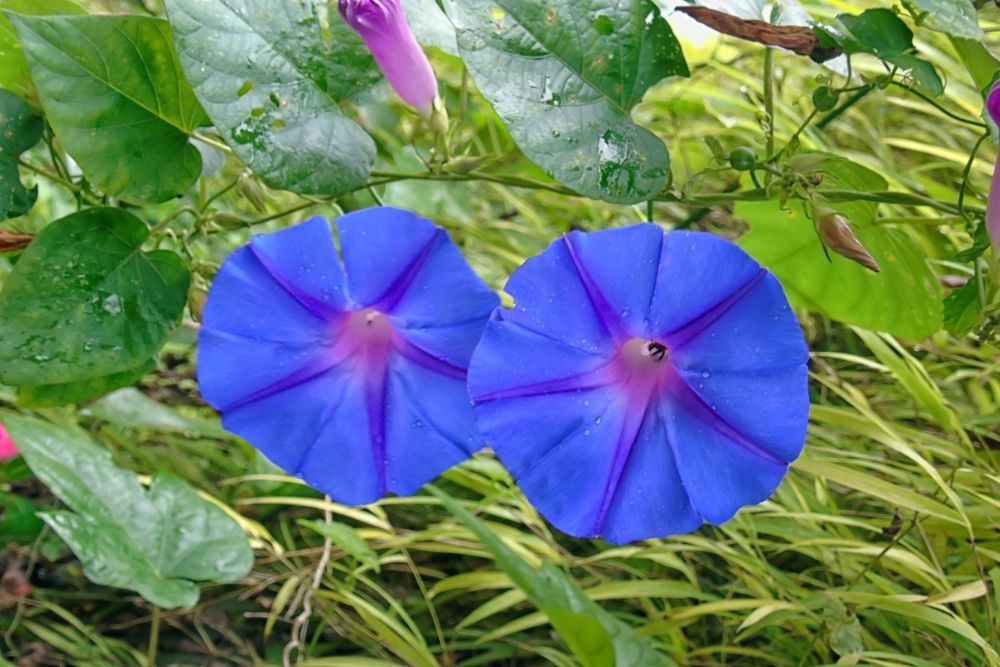
Thunbergia erecta, also known as bush clock vine, is a herbaceous perennial climbing plant that is native to western Africa.
The flowers come in dozens of colors, such as yellow, orange, violet, and red with a yellow center. The purple blooms are slightly fragrant with velvet dark blue to purple flowers that are similar to eggplant flowers in both appearance and color, making them a wonderful alternative.
Growing as single flowers or in clusters, these stunning flowers bloom throughout the summer and the autumn seasons. They are tolerant to drought, and bloom best when they are grown in full sun or partial sun in moist but well-drained soil.
These flowers can grow from 4 to 6 foot tall, and make a wonderful addition to any trellis that you may have in your garden.
In Summary
So, there you have eggplant flowers and a variety of flowers that are the same color as eggplants!
I hope this article has informed you and provided you with a better understanding of eggplant flowers and other purple flowers that are similar to the eggplant flower.
Editor’s Recommendations
How To Use Coffee Grounds In Your Garden CORRECTLY – The Do’s & Don’ts







